Themed collection 2017 Journal of Materials Chemistry C HOT Papers

Recent advances in the chemistry of vat dyes for organic electronics
This review presents an overview of recent developments in the area of vat dye chemistry for the preparation of π-conjugated molecules and polymers for organic electronic applications.
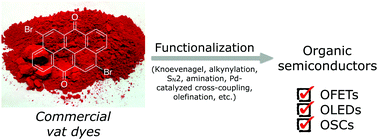
J. Mater. Chem. C, 2017,5, 12298-12307
https://doi.org/10.1039/C7TC03926C
Double D–π–A branched dyes – a new class of metal-free organic dyes for efficient dye-sensitized solar cells
Advantages of the double branched dyes: better fixing, higher loading density, lower aggregation tendency, longer S1 lifetime on the TiO2 surface
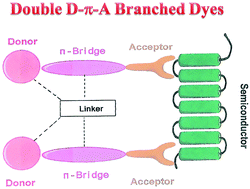
J. Mater. Chem. C, 2017,5, 9828-9837
https://doi.org/10.1039/C7TC03406G
Siloles in optoelectronic devices
This review covers the electronic properties of silole-based organic semiconductors and the newest developments in the field of silole-based OLEDs and OPVs.
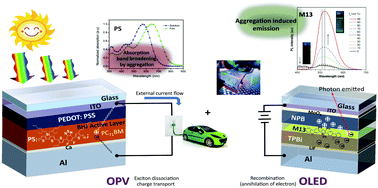
J. Mater. Chem. C, 2017,5, 7375-7389
https://doi.org/10.1039/C7TC02511D
Layer-controlled two-dimensional perovskites: synthesis and optoelectronics
Solution-processed layered-controlled 2D metal halide perovskites are emerging as one of the most promising candidates for low-cost photovoltaics and optoelectronics.
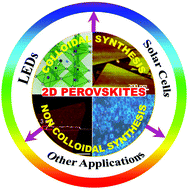
J. Mater. Chem. C, 2017,5, 5610-5627
https://doi.org/10.1039/C7TC00538E
Host–guest composite organic microlasers
In this Review, we present the recent progress in the field of host–guest composite organic micro/nanoscale lasers, and provide our perspective on the future research interests in this area.
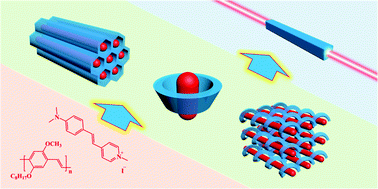
J. Mater. Chem. C, 2017,5, 5600-5609
https://doi.org/10.1039/C6TC05474A
Nanoporous anodic alumina photonic crystals: fundamentals, developments and perspectives
The control of light – its coupling, splitting, modulating, and filtering – is of fundamental importance for the development of advanced, life-changing technologies, which are expected to revolutionise our society in the near future.
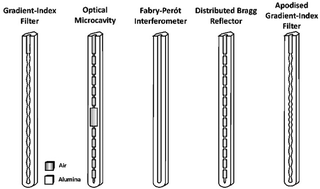
J. Mater. Chem. C, 2017,5, 5581-5599
https://doi.org/10.1039/C6TC05555A
Structure–property relationship of 4-substituted-spirobifluorenes as hosts for phosphorescent organic light emitting diodes: an overview
The aim of the present review is to report the state of the art of an emerging family of molecules, namely 4-substituted spirobifluorenes (SBFs).
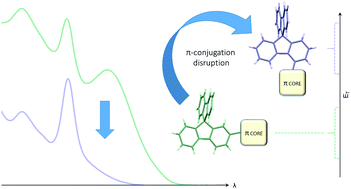
J. Mater. Chem. C, 2017,5, 3869-3897
https://doi.org/10.1039/C7TC00746A
Luminescence spectroscopy of lead-halide perovskites: materials properties and application as photovoltaic devices
This review summarizes the optical properties of lead-halide-perovskite thin films, single crystals, and solar-cell devices.
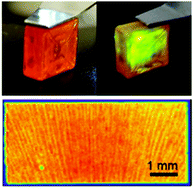
J. Mater. Chem. C, 2017,5, 3427-3437
https://doi.org/10.1039/C7TC00669A
Environmentally benign fabrication processes for high-performance polymeric semiconductors
This review reports on the development of polymeric semiconductors through environmentally friendly manufacturing processes, especially for transistor applications.
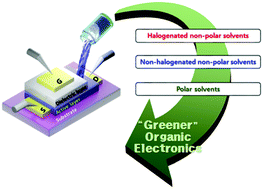
J. Mater. Chem. C, 2017,5, 2745-2757
https://doi.org/10.1039/C6TC05535D
Electronic properties and applications of MXenes: a theoretical review
The recent chemical exfoliation of layered MAX phase compounds to novel two-dimensional transition metal carbides and nitrides, the so-called MXenes, has brought a new opportunity to materials science and technology.
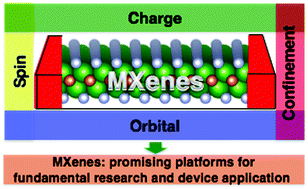
J. Mater. Chem. C, 2017,5, 2488-2503
https://doi.org/10.1039/C7TC00140A
Materials and devices for transparent stretchable electronics
Herein, we review recent advances in transparent stretchable electronic materials and transparent stretchable electronic devices. Some representative examples that highlight the unique optical, electrical and mechanical properties of transparent stretchable materials and devices are also discussed in detail.
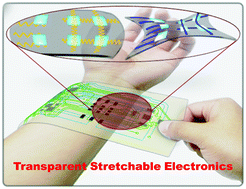
J. Mater. Chem. C, 2017,5, 2202-2222
https://doi.org/10.1039/C6TC05346G
Conductive polymer nanocomposites: a critical review of modern advanced devices
Conductive polymer nanocomposites have found applications in advanced devices: organic light emission diodes, organic photovoltaics, electrochromic devices, and others.
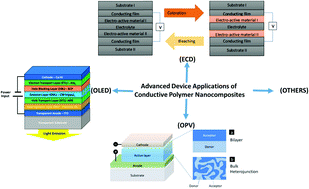
J. Mater. Chem. C, 2017,5, 1569-1585
https://doi.org/10.1039/C6TC04269D
Solvent-cast based metal 3D printing and secondary metallic infiltration
A metal 3D printing method combining a room temperature 3D printing and subsequent heat-treatments: sintering and secondary metallic infiltration.
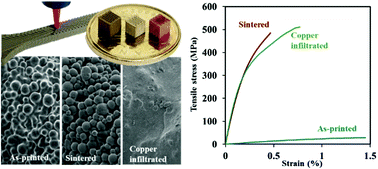
J. Mater. Chem. C, 2017,5, 10448-10455
https://doi.org/10.1039/C7TC02884A
Large strain and strain memory effect in bismuth ferrite lead-free ceramics
An electric-field-induced strain in ferroelectric materials has extensive applications in actuators and sensors.
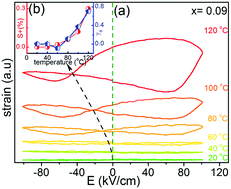
J. Mater. Chem. C, 2017,5, 9528-9533
https://doi.org/10.1039/C7TC03282J
Polarized emission effect realized in CH3NH3PbI3 perovskite nanocrystals
A polarized emission effect has been realized in CH3NH3PbI3 perovskite nanocrystals with a linear polarization degree of 0.28.

J. Mater. Chem. C, 2017,5, 8699-8706
https://doi.org/10.1039/C7TC03104A
Synthesis of formamidinium lead halide perovskite nanocrystals through solid–liquid–solid cation exchange
Hybrid organic–inorganic formamidinium lead halide perovskite nanocrystals can be synthesized through a solid–liquid–solid cation exchange reaction.

J. Mater. Chem. C, 2017,5, 5680-5684
https://doi.org/10.1039/C7TC00598A
The excited-state intramolecular proton transfer properties of three imine-linked two-dimensional porous organic polymers
The excited-state intramolecular proton transfer (ESIPT) properties of three tris(N-salicylideneaniline)-based (TSA) imine-linked porous organic polymers (POPs) were investigated.
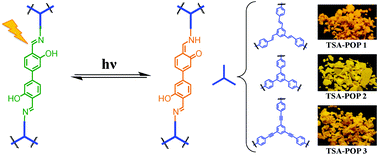
J. Mater. Chem. C, 2017,5, 5676-5679
https://doi.org/10.1039/C7TC00123A
Catalyst-free one-step synthesis of ortho-tetraaryl perylene diimides for efficient OPV non-fullerene acceptors
We report the regioselective ortho-functionalization of PDI with aryl Grignard reagents. OPVs with these non-fullerene acceptors showed PCEs up to 5%, the highest reported for an acceptor with a single PDI core.
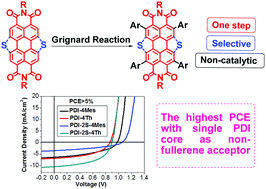
J. Mater. Chem. C, 2017,5, 2781-2785
https://doi.org/10.1039/C7TC00263G
Enhancing field-effect mobility and maintaining solid-state emission by incorporating 2,6-diphenyl substitution to 9,10-bis(phenylethynyl)anthracene
2,6-Diphenyl-9,10-bis(phenylethynyl)anthracene demonstrates improved mobility and comparable solid-state emission compared with 9,10-bis(phenylethynyl)anthracene, suggesting it could be a new and better integrated optoelectronic organic semiconductor.
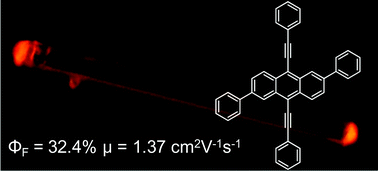
J. Mater. Chem. C, 2017,5, 2519-2523
https://doi.org/10.1039/C7TC00372B
Narrowband spectrally selective near-infrared photodetector based on up-conversion nanoparticles used in a 2D hybrid device
A hybrid (NaYF4:Yb/Er@NaYF4:Nd/Yb)/MoS2 device structure is proposed to realize narrow spectral window photodetection in the near-infrared region.
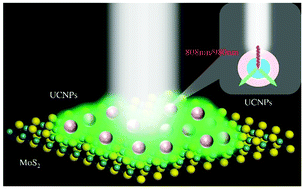
J. Mater. Chem. C, 2017,5, 1591-1595
https://doi.org/10.1039/C6TC05113H
Colour tuning via crystalline site-selected energy transfer in a Sr2SiO4:Eu2+,Pr3+ phosphor
An alternative way to design new luminescent materials based on a site-selected energy transfer mechanism using high precision control of dopants.
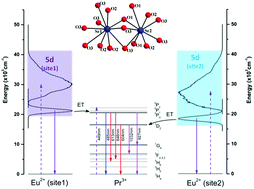
J. Mater. Chem. C, 2017,5, 1022-1026
https://doi.org/10.1039/C6TC04385B
Superbenzene-bridged bis(permethyl-β-cyclodextrin) as a convenient and effective probe for trinitrophenol exploder
Superbenzene-bridged bis(permethyl-β-cyclodextrin) as a convenient and effective probe for trinitrophenol exploder.
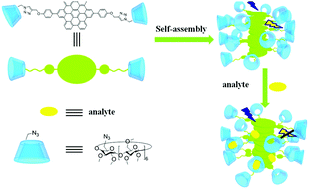
J. Mater. Chem. C, 2017,5, 799-802
https://doi.org/10.1039/C6TC05121A
A photoactivatable light tracer
The photoinduced interconversion of the two emissive states of a photoactivatable fluorophore permits the quantitative mapping of the electromagnetic radiation propagating through microscaled objects in three dimensions.
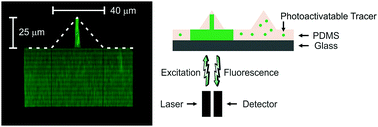
J. Mater. Chem. C, 2017,5, 12714-12719
https://doi.org/10.1039/C7TC05049F
Multi-color perovskite nanowire lasers through kinetically controlled solution growth followed by gas-phase halide exchange
We report multi-color perovskite nanowire lasers on arbitrary substrates through kinetically controlled growth followed by gas-phase halide exchange.
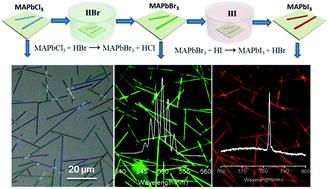
J. Mater. Chem. C, 2017,5, 12707-12713
https://doi.org/10.1039/C7TC03939E
Multi-branch Au/Ag bimetallic core–shell–satellite nanoparticles as a versatile SERS substrate: the effect of Au branches in a mesoporous silica interlayer
An Au/Ag bimetallic core–shell–satellite nanostructure was demonstrated to have high SERS activity due to a large number of accessible tips and nanogaps.
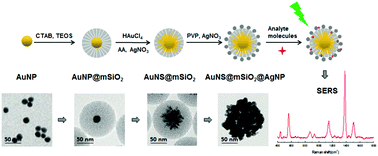
J. Mater. Chem. C, 2017,5, 12678-12687
https://doi.org/10.1039/C7TC03788K
Near-infrared electrochemiluminescence from non-toxic CuInS2 nanocrystals
Electrochemical redox-induced radiative charge transfer in non-toxic CIS NCs was investigated for the first time by ECL.
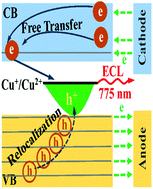
J. Mater. Chem. C, 2017,5, 12393-12399
https://doi.org/10.1039/C7TC04651K
An excellent cyan-emitting orthosilicate phosphor for NUV-pumped white LED application
The Ba9Lu2Si6O24:Ce3+ cyan phosphor has excellent luminescence properties and displays promising application in NUV-based white LEDs with high performance.
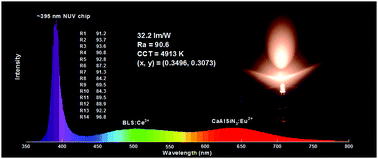
J. Mater. Chem. C, 2017,5, 12365-12377
https://doi.org/10.1039/C7TC04168C
Selective wetting/dewetting for controllable patterning of liquid metal electrodes for all-printed device application
EGaIn liquid metal electrodes have been fine patterned by manipulating wetting/dewetting of the substrate for all-printed device application.
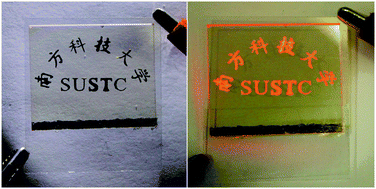
J. Mater. Chem. C, 2017,5, 12378-12383
https://doi.org/10.1039/C7TC03591H
Methoxyl modification in furo[3,2-c]pyridine-based iridium complexes towards highly efficient green- and orange-emitting electrophosphorescent devices
Highly efficient green- and orange-emitting PhOLEDs were successfully realized via a simple methoxyl modification in furo[3,2-c]pyridine-based Ir complexes.
![Graphical abstract: Methoxyl modification in furo[3,2-c]pyridine-based iridium complexes towards highly efficient green- and orange-emitting electrophosphorescent devices](/en/Image/Get?imageInfo.ImageType=GA&imageInfo.ImageIdentifier.ManuscriptID=C7TC04269H&imageInfo.ImageIdentifier.Year=2017)
J. Mater. Chem. C, 2017,5, 12221-12227
https://doi.org/10.1039/C7TC04269H
Triplet decay-induced negative temperature dependence of the transient photoluminescence decay of thermally activated delayed fluorescence emitter
Triplet decay of TADF emitters can be tuned by their molecular structure, leading to the negative temperature dependence of emission decay.
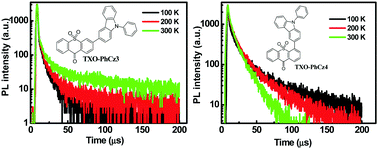
J. Mater. Chem. C, 2017,5, 12077-12084
https://doi.org/10.1039/C7TC04025C
A pair of conjoined donor–acceptor butterflies as promising solution-processable aggregation-enhanced emission FR/NIR EL emitters
The first report on efficient solution-processed FR/NIR AIE/AEE EL materials and devices with light emission at 659 nm and 683 nm, respectively.
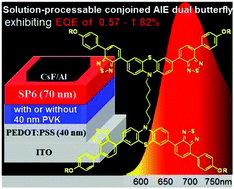
J. Mater. Chem. C, 2017,5, 11700-11707
https://doi.org/10.1039/C7TC04171C
Platinum(II) acetylide complexes with star- and V-shaped configurations possessing good trade-off between optical transparency and optical power limiting performance
Two series of Pt(II) acetylide complexes containing dimesitylborane and phenyl terminal groups with star- and V-shaped configurations were synthesized.
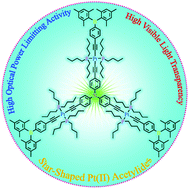
J. Mater. Chem. C, 2017,5, 11672-11682
https://doi.org/10.1039/C7TC03542J
Dopant-free and low-cost molecular “bee” hole-transporting materials for efficient and stable perovskite solar cells
TPD based molecular “bee” dopant-free HTMs for PSCs exhibit a PCE of 15.28% which is comparable to doped spiro-OMeTAD.
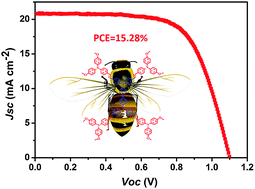
J. Mater. Chem. C, 2017,5, 11429-11435
https://doi.org/10.1039/C7TC03931J
(2-Methylpiperidine)PbI3: an ABX3-type organic–inorganic hybrid chain compound and its semiconducting nanowires with photoconductive properties
Organic–inorganic hybrid semiconducting NWs based on an ABX3-type 1D chain compound show photoconductive properties.
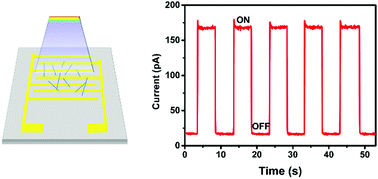
J. Mater. Chem. C, 2017,5, 11466-11471
https://doi.org/10.1039/C7TC03844E
Engineering the excited-state properties of purely organic intramolecular and intermolecular charge transfer emitters towards high-performance fluorescent OLEDs
Purely organic intra- and inter-molecular charge transfer emitters are comparatively studied to show how to develop high-performance OLEDs through tailoring their excited-state properties.
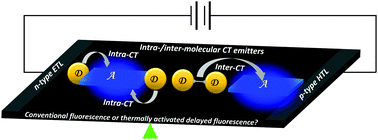
J. Mater. Chem. C, 2017,5, 10991-11000
https://doi.org/10.1039/C7TC04014H
Stamp recyclable contact printing of liquid droplet matrix on various surfaces
We report a direct printing of liquid droplet matrix onto various surfaces with a stamp which can be recycled up to 100 times.
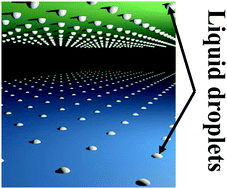
J. Mater. Chem. C, 2017,5, 10971-10975
https://doi.org/10.1039/C7TC03344C
Sb-Doped ZnO microwires: emitting filament and homojunction light-emitting diodes
Individual Sb-doped p-type ZnO (ZnO:Sb) microwires have been synthesized, and could be used to construct wavelength-tuning emitting filaments in the visible region. Meanwhile, ZnO:Sb microwires are applied to fabricate homojunction ultraviolet light-emitting diodes.
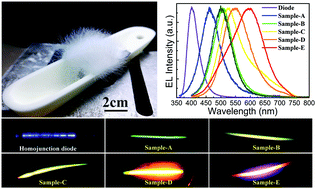
J. Mater. Chem. C, 2017,5, 10938-10946
https://doi.org/10.1039/C7TC03956E
Microwave-assisted synthesis of high-quality “all-inorganic” CsPbX3 (X = Cl, Br, I) perovskite nanocrystals and their application in light emitting diodes
A fast and efficient microwave-assisted strategy is developed to prepare high-quality CsPbX3 nanocrystals with controllable morphologies (nanoplate, nanocube, and nanorod).
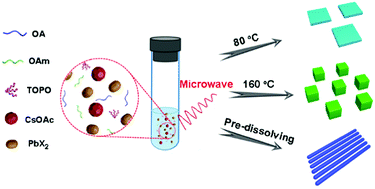
J. Mater. Chem. C, 2017,5, 10947-10954
https://doi.org/10.1039/C7TC03774K
Enhanced electronic transport in Fe3+-doped TiO2 for high efficiency perovskite solar cells
PCE of perovskite solar cells based on Fe3+-doped compact TiO2 is improved from 16.02% to 18.60%.
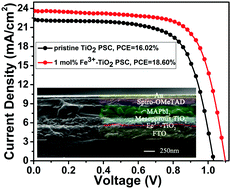
J. Mater. Chem. C, 2017,5, 10754-10760
https://doi.org/10.1039/C7TC03845C
Flash-evaporated small molecule films toward low-cost and flexible organic light-emitting diodes
A flash evaporation method was developed to fabricate small molecule-based multilayer organic light-emitting diodes (OLEDs). The new method can reduce the fabrication cost and avoid the issue of intersolubility in solution-processed multilayer OLEDs.

J. Mater. Chem. C, 2017,5, 10721-10727
https://doi.org/10.1039/C7TC03529B
Intrinsic magnetism and electronic structure of graphene-like Be3C2 nanoribbons and their Si, Ge analogues: a computational study
Utilizing first-principles calculations, we perform a systematic study on the electronic and magnetic properties of recently proposed graphene-like Be3C2 nanostructures.
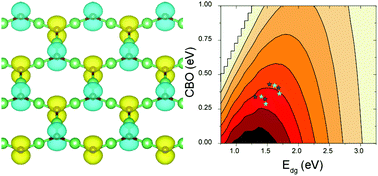
J. Mater. Chem. C, 2017,5, 10728-10736
https://doi.org/10.1039/C7TC03619A
High mobility solution-processed C8-BTBT organic thin-film transistors via UV-ozone interface modification
UV-ozone exposure directly on the dielectric surface to get an OTFT mobility as high as 6.50 cm2 (V s)−1.
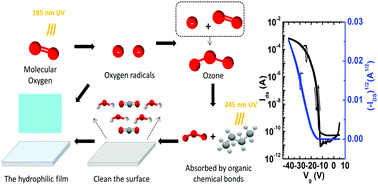
J. Mater. Chem. C, 2017,5, 10652-10659
https://doi.org/10.1039/C7TC03794E
A highly-distorted octahedron with a C2v group symmetry inducing an ultra-intense zero phonon line in Mn4+-activated oxyfluoride Na2WO2F4
A novel Na2WO2F4:Mn4+ red-emitting phosphor, exhibiting an ultra-intense zero phonon line at 620 nm, is demonstrated to be promising for LED lightings and displays.

J. Mater. Chem. C, 2017,5, 10524-10532
https://doi.org/10.1039/C7TC03655H
Towards environmentally stable solution-processed oxide thin-film transistors: a rare-metal-free oxide-based semiconductor/insulator heterostructure and chemically stable multi-stacking
ZTO/Al2O3 heterostructure and chemically stable sol–gel multi-stacking method are proposed for practical solution-processed oxide TFTs.
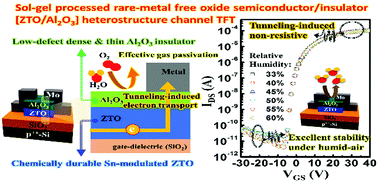
J. Mater. Chem. C, 2017,5, 10498-10508
https://doi.org/10.1039/C7TC03393A
Tracking the maximum power point of hysteretic perovskite solar cells using a predictive algorithm
The predictive algorithm measures and predicts the steady-state current density for each bias set point, which speeds up the tracking process and measures the true maximum power point, regardless of the degree of hysteresis.
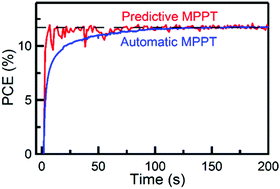
J. Mater. Chem. C, 2017,5, 10152-10157
https://doi.org/10.1039/C7TC03482B
A crack-based nickel@graphene-wrapped polyurethane sponge ternary hybrid obtained by electrodeposition for highly sensitive wearable strain sensors
A highly stretchable and ultra-sensitive strain sensor based on a nickel nanoparticle-coated graphene polyurethane sponge (Ni@GPUS) ternary hybrid material was fabricated.
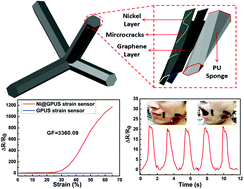
J. Mater. Chem. C, 2017,5, 10167-10175
https://doi.org/10.1039/C7TC03636A
Polarization-manipulated all-optical cross-wavelength data inversion in a C-rich SiCx micro-ring
Polarization-manipulated all-optical format inversion of a 12.5 Gbit s−1 pulsed return-to-zero on-off-keying (PRZ-OOK) data stream is demonstrated through the nonlinear Kerr switching-induced wavelength conversion process.
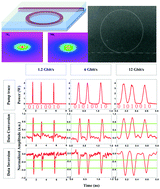
J. Mater. Chem. C, 2017,5, 10158-10166
https://doi.org/10.1039/C7TC02854G
Composite materials combining multiple luminescent MOFs and superparamagnetic microparticles for ratiometric water detection
Luminescent MOFs and superparamagnetic particles form multifunctional composites suitable for ratiometric sensing in liquids by magnetic harvesting and PL read-outs.

J. Mater. Chem. C, 2017,5, 10133-10142
https://doi.org/10.1039/C7TC03312E
Triphenylamine derivatives: different molecular packing and the corresponding mechanoluminescent or mechanochromism property
A new non-AIE unit of triphenylamine, for the first time, is utilized to construct a bright ML luminogen of TPA-1BA.
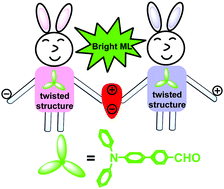
J. Mater. Chem. C, 2017,5, 9879-9885
https://doi.org/10.1039/C7TC03641H
Stable narrowband red phosphor K3GaF6:Mn4+ derived from hydrous K2GaF5(H2O) and K2MnF6
We synthesize a new hydrous single crystal, K2GaF5(H2O), and induce it to convert into stable moisture-proof phosphor K3GaF6:Mn4+ for warm WLED applications by rapidly adding K2MnF6 into its co-precipitate reaction system.
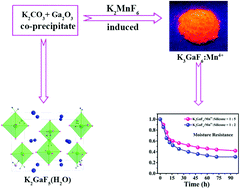
J. Mater. Chem. C, 2017,5, 9588-9596
https://doi.org/10.1039/C7TC03116E
Dithienylbenzodiimide: a new electron-deficient unit for n-type polymer semiconductors
A novel imide-functionalized dithienylbenzodiimide was synthesized and incorporated into polymer semiconductors, which exhibit low-lying FMOs and substantial electron mobilities.
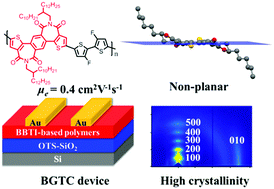
J. Mater. Chem. C, 2017,5, 9559-9569
https://doi.org/10.1039/C7TC02903A
Optical properties of Mn2+ doped cesium lead halide perovskite nanocrystals via a cation–anion co-substitution exchange reaction
The emission colors of cesium lead halide perovskite nanocrystals (NCs) can be controlled by dynamic ion exchange and Mn2+ doping.
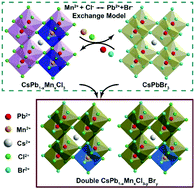
J. Mater. Chem. C, 2017,5, 9281-9287
https://doi.org/10.1039/C7TC03575F
Solution-processed metal oxide arrays using femtosecond laser ablation and annealing for thin-film transistors
A femtosecond laser is proposed to pattern and anneal a metal oxide layer for simple fabrication of metal oxide thin-film transistor arrays.
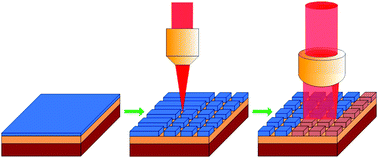
J. Mater. Chem. C, 2017,5, 9273-9280
https://doi.org/10.1039/C7TC01953J
Room-temperature synthesis and optimized photoluminescence of a novel red phosphor NaKSnF6:Mn4+ for application in warm WLEDs
A novel red fluoride phosphor NKSF:Mn was obtained at room temperature by controlling the ratio of NaF to KF. The chromaticity coordinates of phosphor NKSF:Mn are very close to the CIE coordinates of ideal red ascribed to the contribution of particularly strong zero-phonon lines.
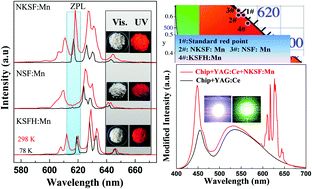
J. Mater. Chem. C, 2017,5, 9255-9263
https://doi.org/10.1039/C7TC02996A
Inverting substitution patterns on amphiphilic cyclodextrins induces unprecedented formation of hexagonal columnar superstructures
Inverting the substitution patterns of amphiphilic cyclodextrins has uncovered their unprecedented abilities to form hexagonal columnar mesophases.

J. Mater. Chem. C, 2017,5, 9247-9254
https://doi.org/10.1039/C7TC02636F
Towards outstanding dielectric consumption derived from designing one-dimensional mesoporous MoO2/C hybrid heteronanowires
1D mesoporous MoO2/C hybrid heteronanowires were designed for outstanding dielectric loss properties.
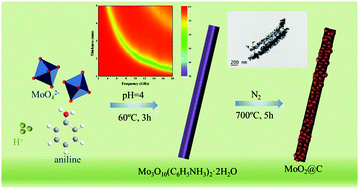
J. Mater. Chem. C, 2017,5, 8981-8987
https://doi.org/10.1039/C7TC02835K
Facile synthesis of monodisperse YAG:Ce3+ microspheres with high quantum yield via an epoxide-driven sol–gel route
Monodisperse YAG:Ce3+ microspheres have been synthesized through a fast epoxide-driven sol–gel route and subsequent heat treatment under a reducing atmosphere. The luminescence quantum yield of the 6 mol% Ce3+ ion doped YAG microspheres was more than 90%.
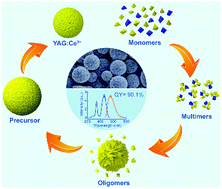
J. Mater. Chem. C, 2017,5, 8952-8957
https://doi.org/10.1039/C7TC02909H
A strong and tough polymer–carbon nanotube film for flexible and efficient electromagnetic interference shielding
A strong and tough CNT-NR film with excellent EMI SE (44.7 dB@250 μm) is realized.
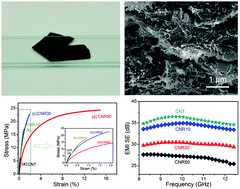
J. Mater. Chem. C, 2017,5, 8944-8951
https://doi.org/10.1039/C7TC02259J
Monolithic Bi1.5Sb0.5Te3 ternary alloys with a periodic 3D nanostructure for enhancing thermoelectric performance
We newly propose a periodic 3D nanostructure to reduce the thermal conductivity of Bi1.5Sb0.5Te3 ternary alloys, which results in a greatly enhanced figure of merit (>50%).
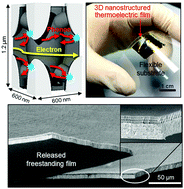
J. Mater. Chem. C, 2017,5, 8974-8980
https://doi.org/10.1039/C7TC02717F
Structural evolutions and significantly reduced thermal degradation of red-emitting Sr2Si5N8:Eu2+via carbon doping
Carbon-doping in Sr2Si5N8:Eu2+ results in enhanced reduction of Eu3+ and the covalence of Eu–(N,C) bonds, finally leading to enhanced thermal degradation.
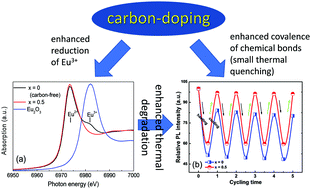
J. Mater. Chem. C, 2017,5, 8927-8935
https://doi.org/10.1039/C7TC02908J
Extra long electron–hole diffusion lengths in CH3NH3PbI3−xClx perovskite single crystals
Both trap-state densities and energy levels affect carrier transfer, resulting in a maximum diffusion length of 380 μm in CH3NH3PbI3−xClx (x = 0.005).
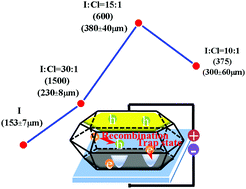
J. Mater. Chem. C, 2017,5, 8431-8435
https://doi.org/10.1039/C7TC02802D
Intermolecular states in organic dye dispersions: excimers vs. aggregates
Efficient energy transfer in dispersed films of organic dyes to dark excimer sites and highly emissive J-coupled dimers.
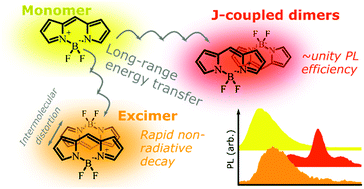
J. Mater. Chem. C, 2017,5, 8380-8389
https://doi.org/10.1039/C7TC02655B
An oxidation-induced fluorescence turn-on approach for non-luminescent flexible polyimide films
To develop stimuli-responsive polymers with highly comprehensive properties, sulfide-containing polyimides with relatively simple structures were designed and synthesized.
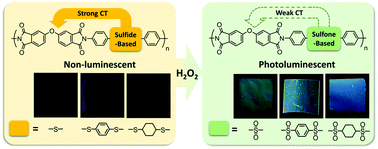
J. Mater. Chem. C, 2017,5, 8545-8552
https://doi.org/10.1039/C7TC01894K
Heating-induced negative temperature coefficient effect in conductive graphene/polymer ternary nanocomposites with a segregated and double-percolated structure
A NTC effect has been developed upon heating in a ternary graphene/PA6/UHMWPE composite with a segregated and double-percolated structure.
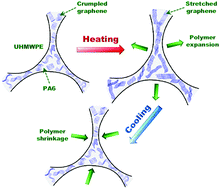
J. Mater. Chem. C, 2017,5, 8233-8242
https://doi.org/10.1039/C7TC02472J
Singlet fission in thin films of metallo-supramolecular polymers with ditopic thiophene-bridged terpyridine ligands
Ultrafast singlet exciton fission in thin solid films after UV laser photoexcitation was observed using transient absorption spectroscopy.
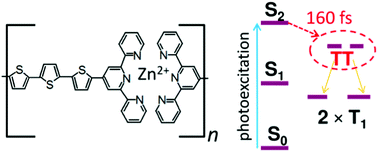
J. Mater. Chem. C, 2017,5, 8041-8051
https://doi.org/10.1039/C7TC00484B
High-performance wide-bandgap copolymers based on indacenodithiophene and indacenodithieno[3,2-b]thiophene units
We demonstrated the synthesis and characterization of two polymers, IDT-T1 and IDTT-T1, to investigate the effect of extending the π-conjugation length on the properties of the copolymers.
![Graphical abstract: High-performance wide-bandgap copolymers based on indacenodithiophene and indacenodithieno[3,2-b]thiophene units](/en/Image/Get?imageInfo.ImageType=GA&imageInfo.ImageIdentifier.ManuscriptID=C7TC01909B&imageInfo.ImageIdentifier.Year=2017)
J. Mater. Chem. C, 2017,5, 7777-7783
https://doi.org/10.1039/C7TC01909B
A systematic study on effects of precursors and solvents for optimization of solution-processed oxide semiconductor thin-film transistors
Here we report a systematic study on the effects of precursors and solvents in solution-processed oxide semiconductor thin film transistors.

J. Mater. Chem. C, 2017,5, 7768-7776
https://doi.org/10.1039/C7TC01779K
Crystal structure and electron transition underlying photoluminescence of methylammonium lead bromide perovskites
A clear insight into the crystal phase related emission mechanism is demonstrated in MAPbBr3.
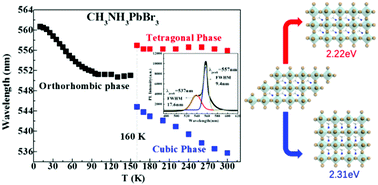
J. Mater. Chem. C, 2017,5, 7739-7745
https://doi.org/10.1039/C7TC01945A
Electromagnetic wave absorption properties of a carbon nanotube modified by a tetrapyridinoporphyrazine interface layer
The CoTAP impedance matching layer is assembled on the surface of CNTs, which can enhance EM absorption and decrease surface reflection.

J. Mater. Chem. C, 2017,5, 7479-7488
https://doi.org/10.1039/C7TC02701J
Thermally stable KxCs1−xAlSi2O6:Eu2+ phosphors and their photoluminescence tuning
The structures and photoluminescence tuning of Eu2+-doped KxCs1−xAlSi2O6 (0 ≤ x ≤ 0.6) phosphors with abnormal thermal quenching behavior have been investigated.
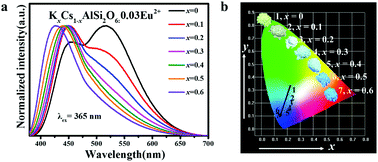
J. Mater. Chem. C, 2017,5, 7489-7494
https://doi.org/10.1039/C7TC02539D
About this collection
This on-going web collection features all the articles published inJournal of Materials Chemistry C in 2017 marked as HOT, as recommended by referees. Congratulations to all the authors whose articles are featured!